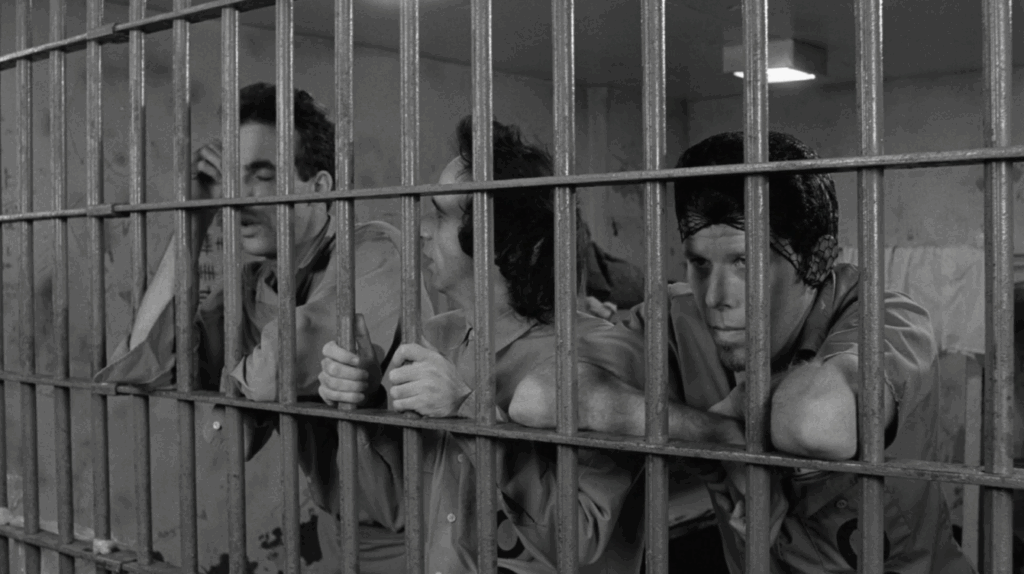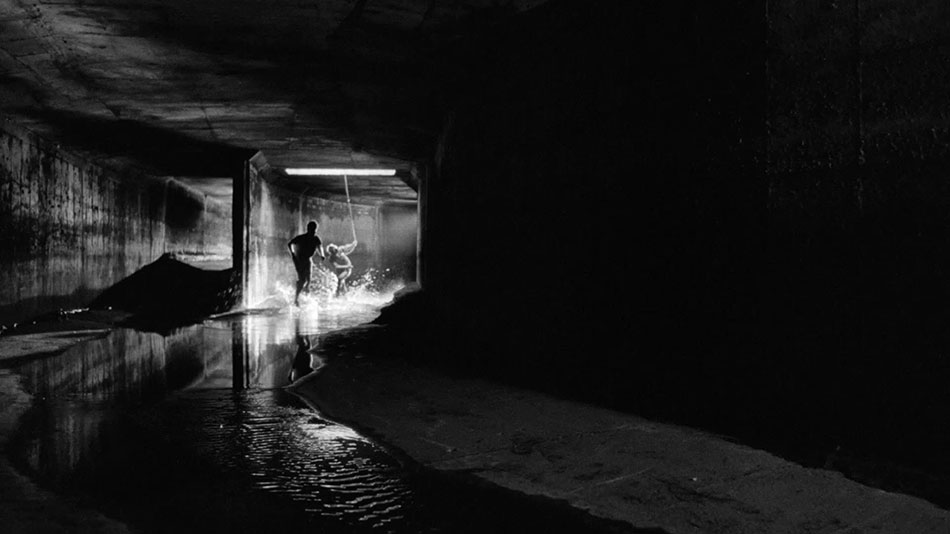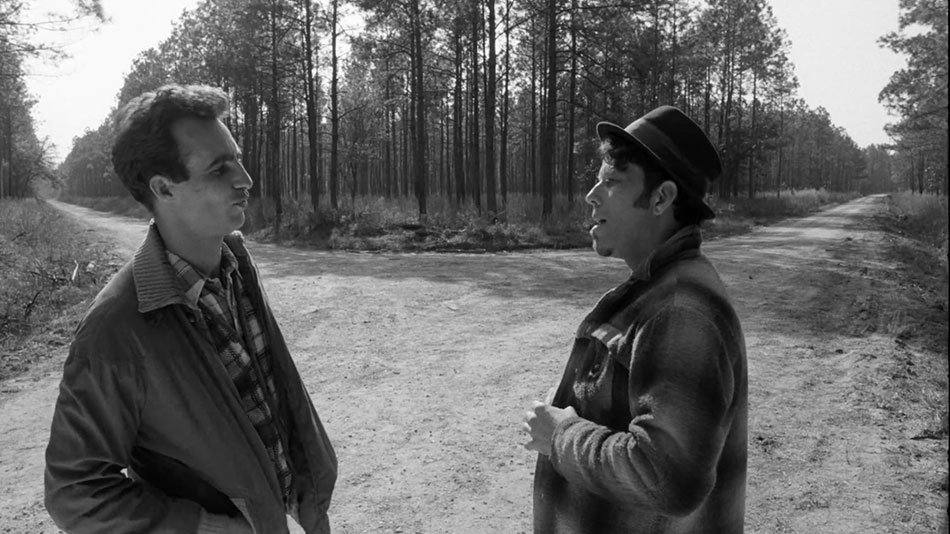| Ryan Sanderson |

Down by Law plays in glorious 35mm at the Trylon Cinema from Friday, November 14th, through Sunday, November 16th. For tickets, showtimes, and other series information, visit trylon.org.
In the first few minutes of Jean-Luc Godard’s 1960 classic, Breathless, Parisian bad boy Michel (Jean-Paul Belmondo) shoots a cop. The moment-as-scripted is very familiar. It’s a classic Hollywood film noir trope—the edgy criminal crosses a boundary from which there’s no going back. As shot and edited, however, this moment (and many like it over the film’s ninety minutes) revolutionized cinema. The gunshot and murder themselves take up hardly any screen time. Where Godard imitates Hollywood conventions, he does so with shaky closeups that call attention to their own artifice. Hitchcock would have wrung minutes of tension from this scene. Godard disposes of it in maybe three seconds. Bang, boom, and then a long shot of Michel running through a field.
There’s a similar moment in Down By Law. Bob (Roberto Benigni) tells his cellmates Jack (John Lurie) and Zack (Tom Waits) about his escape plan. He’s short on the details. They don’t especially matter. We watch all three men sheepishly shuffle out to the yard, and then the camera cuts to all of them running through a sewer. It’s not quite the same angle or energy as Michel running across the field in Breathless, but I’m still convinced of their connection. Where Godard made a crime film in which the crime is secondary, Jim Jarmusch made a prison break movie where the break-out itself happens off-screen.

This is not the only similarity between these two films. Both were made by auteurs with prickly relationships with genre filmmaking. Godard swore off Hollywood-style genre filmmaking for good after Breathless, claiming for a while that he was ashamed of the film. Later he said he learned to like it, but compared it to Alice in Wonderland. Jarmusch’s one note to cinematographer Robby Müller about the look and feel of Down By Law: “It’s a fairy tale.” Jarmusch has been a bit less hard-nosed in this regard than Godard. Across his legendary career he’s made forays into the western (Dead Man), vampires (Only Lovers Left Alive), zombies (The Dead Don’t Die), and whatever The Limits of Control was. However, none of those films are standard genre storytelling. They balance a genuine affection for certain old kinds storytelling with an unsparing drive to revise and refocus.
In a 2002 Criterion Q&A for Down by Law, Jarmusch was asked: “What’s the larger influence on your work, the French New Wave or the New York punk scene?” He hesitated before saying the New York Punk scene, then added that he was “certainly very influenced” by Godard and Jacques Rivette. Godard, who was a critic for a decade before he started filmmaking, said, “Instead of writing criticism, I make a film, but that includes a critical dimension.” Aesthetically, Jarmusch is one of the last filmmakers to whom I would apply that line. It’s not like he makes plotless experimental art films, but the balance skews heavily in favor of immersion over didacticism. That’s one area where Down By Law and Breathless are quite different. Godard worked in a decent amount of philosophical and social debate. He enthusiastically pulled the audience out of the story so they would be forced to engage with his larger points. You can read Jarmusch’s films, but I think he’d prefer you feel them.
That said, I think Jarmusch’s choice to follow the critical and commercial success of his meticulously aimless mood piece Stranger than Paradise with a (partial) riff on Breathless emphasizes that very point. The mood, the behavior, the low hum rhythm and fascination that immerse and sustain us through the seemingly quiet and unimportant moments–all of that is the ideology.

Both films at their core are about relationships. Michel is betrayed by Patricia (Jean Seberg). When we meet Jack (John Lurie) and Zack (Tom Waits), they’re both arguing with the women in their lives. Godard includes debates (between men) over the relationship between men and women. Jarmusch avoids this (thank God). There’s a ton to unpack about these scenes, but I think it’s notable that both men grow, not through their interactions with another woman, but through being forced to bond with each other.
Both Jack and Zack are living pretty wretched lives as the film begins. They both fancy themselves different kinds of outlaws, inspired by projections of what they consider manhood (much like Jean-Paul Belmondo’s Michel looking at Bogart in Breathless—okay, last one, I promise). For Jack, it’s hardness. He pretends to ignore Billie Neal’s Bobbie as she tries to get under his skin. And yet she’s right. It is all a put-on, evidenced by the way he walks into an obvious trap. He has no clue what he’s doing. We first meet Zack in front of his bedroom wall, covered in scribbled poetry and quotes. The dude’s a bit literate. He’s a radio DJ, so art-adjacent as well. After the opening credits, Ellen Barkin’s Laurette throws all of Zack’s stuff out the window of their apartment. She also shouts insults at him and tries to get under his skin. His facade is more of a cool detachment. Barkin chucks his records out the window. No comment. She tosses equipment. Nothing. She insults his livelihood and beliefs. A halfhearted reply. She grabs his shoes. He stands up to stop her. That’s what he really cares about—style.
Jarmusch noted the title’s double meaning in a press conference when the film debuted at Cannes in 1986. “The literal meaning is the opposite of the slang meaning. Literally you would assume it means oppressed by the law or held down by the law. But it’s street slang from American black culture, really from the twenties when it originated. It means, ‘I know my way around. I’m in control of myself. I’m down by law.”

That kind of self-possession is central to Jarmusch’s work, and to the work of many of those with whom he collaborates. Note Forest Whittaker’s line in Ghost Dog: The Way of the Samurai: “There is surely nothing other than the single purpose of the moment. A man’s whole life is a succession of moment after moment. If one fully understands the present moment, there is nothing left to do, and nothing else to pursue.” Or RZA’s line in The Dead Don’t Die. “The world is perfect. Appreciate the details.” Consider the moment in Paterson where Adam Driver gives into melodrama. The next day he’s cosmically punished. The dog rips all his poetry to shreds.
This is what makes Jim Jarmusch one of my favorite filmmakers. He rarely asks the audience to sift through his poetry. Through the methodically paced editing, the rhythm of the music, the genuine evolution of behavior, the pure cinema of it all, he transforms the audience into poets. Jarmusch’s films repeatedly suck me in and leave me feeling like a stronger, more observant, more patient human being. It’s a real trick. Movies in general do this for me, but Jarmusch does it on a level shared by no other filmmaker I’m aware of. He’s just so good at lulling the viewer into a space where behavior and tiny details matter immensely. Take the “I scream for ice cream” scene. Bob (Roberto Benigni, who I promise I’m getting to) starts the adolescent chant. Initially Zack and Jack are annoyed. To be honest, I’m a little annoyed too. Eventually, through sheer persistence, Roberto wins us over. Soon all three men are dancing in a circle, repeating the same line, clapping and shouting. Soon the whole prison block joins in. The angle shifts so each man’s face passes in turn between the frame of the bed posts, and their expressions and energies as they dance past the camera become the most fascinating thing in the world.
That’s what’s so remarkable about Down By Law. It transforms a narrow prison cell full of men with potentially irritating excesses into a place I never want to leave.

Probably my favorite scene in the movie is Roberto and Nicoletta (Nicoletta Brasci) dancing together. Within their dance you see all the intimacy and playfulness and vulnerability that Zack and Jack have been unable to experience because of all their posturing. Jarmusch said that he wrote the character of Roberto after meeting Benigni in Rome. The Cannes press conference is a really fascinating artifact on this subject. Benigni acts almost exactly like his character in the film. It’s fascinating to see Jarmusch and Lurie (apparently you cannot drag Tom Waits to a Cannes press conference, which I’m happy to know) looking so similar to Zack and Jack—amused, maybe, but definitely not participating or matching the energy of their Italian ultimate theater kid collaborator, who relentlessly clowns to the Cannes audience’s uproarious laughter. You can see why Jarmusch—as opposite Benigni’s energy as a person could possibly be—may have wanted to memorialize their relationship on screen. Men of very different dispositions and worldviews learn to live together, not just tolerantly but affectionately, with an appreciation for the unique and idiosyncratic way their partner has learned to navigate this world.
Moreover, note Roberto’s face as he and Nicoletta dance. He’s all smiles and big energy for the public, but when her face blocks him from the others’ view, the facade lowers. For a moment you see the serious man relax his guard. If Roberto was some idealized symbol of innocence, I think this would cheapen the film significantly. Sure, both Zack and Jack learn something about simplicity and trust and freedom from a man who is in so many ways their opposite. And in this way a concession is made to softness and geniality and performance, from a filmmaker whose earliest works were in large part a rebellion against the superficiality of those very qualities. However, the audience still leaves with Zack and Jack in the morning, for that fork in the road to lands as-yet unknown.

Edited by Olga Tchpeikova-Treon
